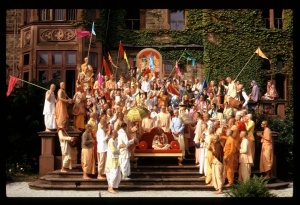CC Madhya 9.279

A.C. Bhaktivedanta Swami Prabhupada
TEXT 279
- tritakūpe viśālāra kari’ daraśana
- pañcāpsarā-tīrthe āilā śacīra nandana
SYNONYMS
tritakūpe—to Tritakūpa; viśālāra—of the Deity named Viśālā; kari’—doing; daraśana—visiting; pañca-apsarā-tīrthe—to Pañcāpsarā-tīrtha; āilā—came; śacīra nandana—the son of mother Śacī.
TRANSLATION
Śrī Caitanya Mahāprabhu, the son of mother Śacī, next went to Tritakūpa, and after seeing the Viśālā Deity there, He went to the holy place known as Pañcāpsarā-tīrtha.
PURPORT
The Apsarās, denizens of the heavenly planets, are generally known as dancing girls. The girls in the heavenly planets are exquisitely beautiful, and if a woman on earth is found to be very beautiful, she is compared to the Apsarās. There were five Apsarās named Latā, Budbudā, Samīcī, Saurabheyī and Varṇā. It is said that these five beautiful dancing girls were sent by Indra to break the severe austerity of a saintly person called Acyuta Ṛṣi. This action was typical of Indra, the King of heaven. Whenever Indra discovered someone undergoing severe austerities, he would begin to fear for his post. Indra was always anxious about his position, fearing that if someone became more powerful than he was, he would lose his elevated position. Thus as soon as he would see a saint undergoing severe austerities, he would send dancing girls to distract him. Even the great saint Viśvāmitra Muni fell victim to his plan.
When the five Apsarās went to break Acyuta Ṛṣi’s meditation, they were all chastised and cursed by the saint. As a result, the girls turned into crocodiles in a lake that came to be known as Pañcāpsarā. Lord Rāmacandra also visited this place. From Śrī Nārada Muni’s narration, it is understood that when Arjuna went to visit the holy places, he learned about the condemnation of the five Apsarās. He delivered them from their abominable condition, and from that day the lake known as Pañcāpsarā became a place of pilgrimage.